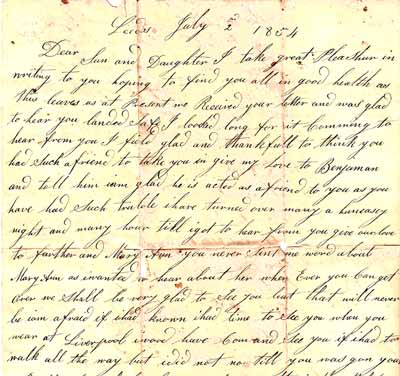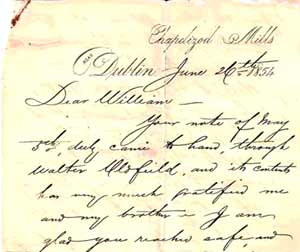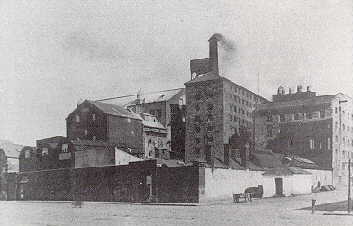| Welcome
Timeline
Census
Sewing
Machines
Benjamin
Webster (m. Calam)
Benjamin
documents
275
Maple Street, Bridgeport
Letters
to William
California
timeline
reference
The
collaboration
~
~
Contact Beth Northrop
ejnorth123 AT juno.com
|
Letter from friend mentioned letter dated
5/5/1854 with news of safe arrival in his new country. With the
date, this might be William Holmes, not William Webster. Then again
with the matches on the names, perhaps the date is wrong.. It does
give a picture of the Thread/Yarn indistry in Leeds at the time.
The second is a letter of father to son at a time when
they could not know when or if they would hear from or see each
other again. |
|
"Leeds July 2nd, 1854
Dear Sun (sic.) and Daughter I take great Pleashur in writing
to you hoping to find you all in good health as this leaves us
a Present we Received your letter and was glad to hear you landed
Safe. I look long for it Comming to hear from you. I field glad
and thankfull to think you had such a friend to take you in give
my love to Benjamin and tell him i am glad he is acted as a friend
to you as you have had such truble I have turned over many a huneasy
night and many hour till igot to hear from you give our
love to farther and Mary Ann you never sent me word about Mary
Ann as iwanted to hear about her when Ever you Can get
over we Shall be very glad to See you but that will never be iam
afraid if ihad known ihad time to See you when you wear at Liverpool
iwood have com and see you if ihad to walk all the way but idid
not now till you was gon your Brother Samuel has bean
up three months in the Militia he is now at berwic on
tweed ihad but two of you at home but now ihave neither of you
at home o Speak to now we Could have liked to see your
little Sun we have many a little present for him from
his Sisters they all send their love to you and hopes you will
do well as they all have a very grate desir to see you especialy
you Sister Ellen he often Sheds tearabout you
She Sends her kind love to little Josh i am Expecting
aletter from your cousin Richard but imay have a letter whn i
write to you again the last time iheard of him he wasstill at
Boston your Gradmfather and Grandmother is still alive
dear son i wish i ware with you in america we should of wrote
before now but we wants to get an understanding a bout these fesons
eggs it is to late this thisons there is you ng /wg? fesons
now i sent to my brother George at Pegburn (pangburn?)and
he can get any quantity you like a quinst a nother seasons you
must send me word how they can get to America you must send us
word wat quantity you will want beqisct and then so xxx so no
more at present from your father mother so good might and god
bless you."

|
I wonder about the text of this letter - could it be that it
was taken down by someone else? I guess the mispellings of common
words the words run together make me wonder was this from someone
who was less educated, sight impaired? or spoken to someone else
who wrote it down?
Believe feson refers to pheasant.
"Tim Payne, wildlife specialist with the Department
of Natural Resources, says he’s heard of poaching incidents,
though nobody tracks the bird population in Detroit.
Payne says that pheasants are indigenous to China, but were
brought to the United States in the 1850s. Their numbers in Michigan
dwindled drastically in the 1960s and 1970s, likely due to such
agricultural practices as the use of toxic pesticides."
http://www.metrotimes.com/editorial/story.asp?id=5344 Metrotimes
detroit's weekly alternative
A relative of the peacock, the pheasant is native to Asia.
It was introduced to California
in the 1850s and now lives in most of the United States (including
Hawaii) except the
southern states where it is too hot for it to survive.
gageoutdoor expeditions |
Chapelizod Mills

NEARDublin June 26th 1854
Dear William --
Your note of May 5th duly came to hand, through Walter Oldfield
and its contects has very much gratified meand my brother. I am
glad you reached safe and have commenced your labours in your
new country. I am sure you will always command high wages in the
states, and higher in proportion with your own friend. but then
there must be something objectionable to a strange place that
is so different to this country. I feel much obliged for the description
of the country which you gave. Joshua rothen passed through here
last week- he did not come down yo see me but called at Walter
Oldfields who saw him - He was on his way to Limerick to Russells
Mill. We are very busy now at the new Engine and water which,
most of all of which are in the yarns, but part of the Engine
is all that is yet put up. however we stop in about a fortnight
to erect all and the shaft, and I fear we shall be off 2 months.
The thread trade is very good indeed. London and America gives
us more than we can do but in a little time we will be large producers.
The Yarn trade could not be worse. None selling and the mills
are stopping in all directions. Some parties have failed and others
throwing off machinery. Fine yarns are the druf,(underline) in
fact we are ourselves stopping 17 frames, 1 3/4 & 2 In pitch.
Coarse yarns are high priced and scarce owing to our not been
now able to get flax from Russia on account of the war. Any price
now for coarse stuff, in the way of ropes, canvas, duck, low linen,
? and this state of affairs look as if it would continue, for
although the Russians have been beaten in all directions by the
Turks. Yet it, I fear, will be a long war, and most expensive
since you left provisions have gone up very high, every thing
eatable is up double, which, with general bad trade, is severe
on working people. If I can be of any use to you, I shall be glad
to render you any services I can and with best wishes for your
success and comfort I am yours truly
Benjamin Laughton Jnr.
|
http://www.from-ireland.net/lewis/d/cizod.htm
description from Lewis's Topographical Dictionary of Ireland, 1837
This place is supposed to have derived its name from La Belle
Isode a daughter of one of the ancient Irish kings, who had a
chapel here. The lands belonging to it were granted by Hugh de
Lacy, in 1173, to Hugh Tyrrell, which grant was afterwards confimed
by Hen. II. In 1176, they were given by the Tyrrells to the hospital
of the Knights Templars of Kilmainham, and after the suppression
of that order remained in possession of their successors, the
Knights of St. John of Jerusalem, till the dissolution of the
monasteries, in the reign of Hen. VIII. They subsequently passed
through various hands till 1665, when the Duke of Ormonde, by
command of the king, purchased the entire manor, with the mansion,
from Sir Maurice Eustace, for the purpose of enclosing the Phoenix
park, and the old mansion-house became the occasional residence
of the Lord-Lieutenant.
The woollen manufacture was formerly carried on very extensively,
and continued to flourish till the commencement of the present
century, when there was a large factory, two fulling-mills, and
an extensive corn and wash nill, which have been succeeded by
a flax-mill on a very large scale, erected by Messrs. Crosthwaite,
the present proprietors, and affording constant employment to
more than 600 persons. There are also a bleach-green and several
mills.
|
The street rising to the right in this photograph is Mallow Street.
The main view is of Russell's Mills which processed grain for
export. The granary, the tallest building in the photograph, is
also visible in the photograph above. The street in the foreground
is the Dock Road. the site of Russells Mills is now occupied by
a 1960's office building which seems out of place in the grand
architecture of Limerick! In the space just off the right hand
side of the photograph now stands Jurys Inn. Our walk takes us
up Mallow Street, passing the front of this hotel.

http://homepages.iol.ie/~avondoyl/angelas2.htm The Limerick of
Angelas Ashes
Chapelizod
The village of Chapelizod, which lies between Island Bridge and
Palmerston, and is picturesquely situated on the northern bank
of the river Liffey, contains now a flour mill and distillery,
and is mainly occupied by persons employed in them. Although here
and there one sees an old time house that has seen better days,
the thought would never suggest itself that Chapelizod had once
been the site of a great mansion. Yet such was the case, and in
a field sloping down to the Liffey on the south of the road from
Dublin stood what was known as the King's House in which William
III. held his court for some days.
An ancient tradition connects Chapelizod with La belle Isoude,
the heroine of the poets, and traces the origin of the place-name
to her. According to the "Book of Howth" she was the
daughter of Anguisshe, King of Ireland, who flourished in the
days of King Arthur and the knights of the round table. To King
Anguisshe, a King of Cornwall called Mark had been wont to pay
tribute, but he disputed his obligation to do so, and it was determined
that the question should be decided by combat between two knights.
The knights, Sir Marlyn, a brother of the Queen of Ireland, representing
King Anguisshe, and Sir Tristram representing King Mark, met in
Cornwall with the result that both were wounded in the conflict.
Although able to return to Ireland Sir Marlyn soon died, and after
his death Sir Tristram, whose wound had been caused by a poisoned
spear, came to this country, as he was told none except La belle
Isoude could cure the hurt.
The Queen of Ireland had taken out of her brother's wound a piece
of iron, which she had kept, and observing one day a gap in Sir
Tristram's sword she was prompted to try whether this piece of
iron fitted it, She found that they agreed, and forthwith caused
her brother's adversary to be banished from the Irish court, but
meantime he had won the heart of La belle Isoude, who followed
him to England.
Whether this tale has any foundation in fact, or whether, if
so, La Belle Isoude had any connection with Chapelizod must remain
a matter of doubt, but a spring called Isoude's font, which lay
between Kilmainham and the Phoenix Park, as well as a building
called Isoude's tower in the walls of old Dublin, tend to indicate
that at some period a celebrated person of the name of Isoude
was resident in Dublin or its neighbourhood.
wickipedia |
|
"Both letteres seem to refer to the same thing ie the arrival
of "William " in American - so I think the dates are
correct .
It was normal in the 1850s to write things down as they sounded
. I had great difficulty in finding John Edward Whiteleys father
- He was in fact John Wakely who was illiterate and came from
Ireland to Leeds around the time of the Irish famine -about 1850.
. Whiteley is a common Leeds name- If you say Wakely with a WH
and quiet K it sounds like Whiteley - which it became.
Assuming the date is correct - "little Josh" -could
be Joshua Holmes ( WWs brother in Law) born c 1852 ie age 28 in
the 1880 census.
Boston could be Boston Lincolnshire UK
If the "ng / wg" joins the "you" at the end
of the previous line to make young it means this years pheasants
have hatched out.
Pegburn is Pickburn or Pigburn - a small village about 20 miles
SE of Leeds .
I have an 1851 Leeds census index - there is a household with
the following Holmes :- William 28 , Hannah 29, Samuel 15, Mary
6. This looks right with Joshua not yet born and ( brother ) Samuel
the right age to go in the militia in 3 years time.- Ill try to
get further detail on this."
Paul Whiteley
|
|


